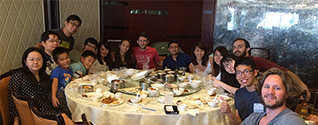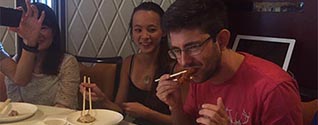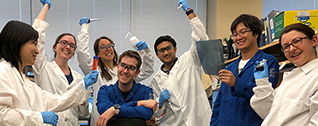Small RNA Protocols Carring2
PROTOCOLS FOR RNA EXTRACTION, LOW MOLECULAR WEIGHT RNA ISOLATION AND SMALL RNA DETECTION
Note: Please also read this email when you read this protocol.
Carrington Lab Protocol
Center for Gene Research and Biotechnology
Department of Botany and Plant Pathology
Oregon State University
TOTAL RNA EXTRACTION
* Clean your material (tubes and caps) with a 10% SDS-containing solution and rinse thoroughly with distilled-water.
* Start with 1 g of plant tissue for extraction. Put plant tissue into clean mortar and add sufficient amount of liquid N2 to cover the tissue and freeze completely. Grind the tissue while frozen into a fine powder.
* Homogenize tissue samples by adding 10 ml of Trizol reagent (GibcoBRL) to powder before it begins to thaw. Stir and add liquid to clean 30 ml tubes. Keep in ice until you are done grinding all your samples.
* Incubate the homogenized samples for 5 min at room temperature (RT) and then add 2 ml of chloroform. Cap sample tubes!
* Shakes tubes vigorously by hand for 15 seconds and incubate them at RT for 3 min.
* Centrifuge the samples at 10,000 rpm for 15 min at 4°C. Following centrifugation, the RNA remains exclusively in the upper aqueous layer whereas proteins and DNA remain in the organic (phenol:chloroform) phase.
5a. Repeat steps 2 through 5 until white layer at interface is no longer present (1-2 times).
* Transfer the aqueous phase (top layer) to a fresh tube and add 1 volume of cold isopropanol.
* Incubate the samples for 20-30 min at RT and centrifuge at 10,000 rpm for 10 min at 4°C.
* Remove the supernatant and briefly air-dry the pellet (do not use speed-vac!!). Dissolve the RNA pellet in 1 ml of DEPC-treated H2O.
[More details on RNA isolation using the Trizol reagent can be found in the instruction manual supplied with this product. Low Molecular Weight (LMW) RNA is further purified using the RNA/DNA Midi kit from QIAGEN (Cat. No. 14142). Detailed instructions for isolation of LMW RNA are provided in the QIAGEN RNA/DNA Handbook (pages 49-52) supplied with the kit]
LOW MOLECULAR WEIGHT RNA ISOLATION using the RNA/DNA Qiagen
* Add 1 ml of Buffer QRL1 (+b-ME) to the total RNA preparation, mix thoroughly by vortexing and incubate for 5 min at 65°C.
* Cool down your samples on ice and then add 9 ml of buffer QRV2. Mix thoroughly by vortexing.
* Add 3 ml of QRE equilibration buffer to the columns and allow the buffer to enter by gravity flow.
* Centrifuge the samples at 6,500 rpm for 5 min at 4°C.
* Apply your sample (supernatant) to the QIAGEN-tip, and allow it to enter by gravity flow. Discard the flow through.
* Add 12 ml of buffer QRW to the QIAGEN-tip to wash away contaminants, and allow it to enter by gravity flow. Discard the flow through.
* Add 6 ml of homemade QRW2 buffer to the QIAGEN-tip and elute LMW RNA by gravity flow into 15 ml Corex tubes. (30 ml Corex are also OK).
* High molecular weight RNA may be eluted after the LMW RNA by adding 6 ml QRUR to the QIAGEN-tip and collecting the elute in a 15 ml Corex tube.
* Add 6 ml (1 vol) of cold isopropanol to the eluate. Mix vigorously and incubate on ice for 60 min at 4°C.
* Centrifuge your samples at 10,000 rpm for 30 min at 4°C and carefully remove the supernatant.
* Add 4 ml of 70% Ethanol to the RNA pellet. Shake carefully and centrifuge at 10,000 rpm for 10 min at 4°C. Carefully remove the supernatant.
* Air-dry the pellet for 15 min at RT (do not dry under vacuum!!!).
* Dissolve the LMW RNA in 60-80 ml of DEPC-treated H2O (HMW RNA in 200-300 ml of DEPC-treated H2O) by pipeting back and forth. (Notice that the RNA pellet may remain not only at the bottom of the Corex tube but also on the sidewall of the tube).
* Transfer your samples to a labeled-eppendorf tube and quanitate your RNA in a spectrophotometer to a 1:100 dilution.
* Store your samples frozen at - 80°C until use.
High Molecular Weight RNA can be collected off the columns after the Low Molecular Weight RNA. The protocol is in the RNA/DNA Qiagen Kit.
Buffer QRW2
(750 mM NaCl, 50 mM MOPS, pH 7, 15% (v/v) Ethanol)
Vol=100 mol
MOPS-----1.04 g
H2O-----70 ml
Adjust pH to 7.0 with NaOH
5M NaCl-----15 ml
EtOH-----15 ml
NORTHERN BLOT ANALYSIS OF SMALL RNAs
LMW RNA isolation provides excellent results for small RNA detection in Northern blots. Electrophoresis of RNA samples in denaturing 17% polyacrylamide gels should be done as described below.
Tricks and suggestions:
* Clean your material (plates, spacers and comb) with Liquinox, followed by a 10% SDS-containing solution, and rinse thoroughly with distilled-water.
* Rinse with 95% EtOH
* Use plates of 14 cm x 16 cm and 1.5 mm spacers.
* Seal the outside edges of your plate set-up with 1-2% agarose using a Pasteur pipet to avoid undesirable leaking.
Preparing a 17% polyacrylamide gel containing 7 M Urea in 0.5X TBE
V = 30 ml
30% polyacrylamide (acrylamide:bis, 37.5:1) 17 ml
Urea-----12 .6 g
TBE 10X-----1.5 ml
H2O-----2 ml
Mix thoroughly, do not vortex, and heat to 37°C to dissolve the urea. Then add:
TEMED-----15 ml
(Mix by inversion, do not vortex)
then
25% Ammonium Persulfate (APS)-----60 ml
(Mix quickly by inversion, APS should be fresh within 3 months)
Pour the gel and allow it to polymerize for 1 to 2 hours.
Assemble your electrophoresis device; add the running buffer (0.5X TBE).
Rinse wells out using a syringe.
Pre-run the gel at 180 volts in 0.5X TBE buffer for one hour.
Rinse wells again right before loading samples.
Preparing your RNA samples and running the gel
* Keep sample volume to a minimum for best resolution.
* Prepare master loading buffer containing 2 volumes formamide: 1 volume 5X BPB loading buffer
* Bring all samples to volume equal to lowest concentration RNA using dH20, add 1.5 volumes master loading buffer (run 5 – 20 µg LMW RNA). Use the lowest volume possible.
* Heat at 95°C for 4 min and immediately cool down on ice.
* Spin briefly to bring volume to the bottom of the tube.
* CRITICAL: SAMPLE LOADING DETERMINES THE ULTIMATE QUALITY OF YOUR GEL! We use Fisher Tips (02-707-182) to load small RNA gels. You want to load the sample at the very bottom of the well in a flat band, no triangles, blobs, or other sloppy loading! Lots of patients, no trailing up. All settled at the bottom. If it too diffuse in the lane, then the bands will be diffuse and bad.
* Load your samples into bottom of wells using small tip pipets; electrophorese at 180 volts in 0.5X TBE buffer until the dye reaches the bottom of the gel.
Markers:
RNA markers are the best. DNA oligonucleotides run slightly faster than RNA markers do but they have the advantage of being far cheaper. For DNA oligonucleotides prepare a standard-mix containing oligos 18 to 30-nt long. Add at least, 500 pmoles of each so they are easily detected by staining of the gel with ethidium bromide. Prepare your marker mix in the same manner as you did with your RNA samples. For RNA markers we ordered 5’ phosphorylated oligos 21 and 24 nts in length from Dharmacon Research. The oligos are deprotected before use. The proper concentration for the markers is determined by running a test gel with a dilution series. For a standard 0.2mM stock dissolved in 250ml, 1ml is a good starting amount to load. For hybridization controls, start with 250pg RNA oligo.
4X BPB (bromophenol blue) loading buffer.
50% glycerol-----50 ml
0.03% BPB-----0.03 g
50 mM Tris pH 7.7-----5 ml of 1 M stock
5 mM EDTA-----1 ml of 0.5 M stock
H20-----to 100 ml
Transferring polyacrylamide gels using the Bio-Rad semi-dry transfer unit
* Stain the gel in 0.5X TBE containing EtBr for 5 min. Destain in 0.5X TBE.
* Carefully, put the gel on a Saran wrap plastic film and take a picture using a UV transilluminator to visualize the position of the 5S rRNA and tRNAs. Lay a ruler alongside the gel as a reference so that size standards can later be identified on the membrane.
* Rinse the gel with 0.5X TBE to remove the excess of EtBr. Meanwhile, set up the transfer device. I currently use the Trans-blot semi-dry transfer cell of Bio-Rad.
* Cut the nylon membrane (Nytran SuperCharge membranes, Schleider & Schuell) to a slightly larger size as the gel, wet membrane in DI water and, equilibrate it in 0.5X TBE for 5-10 min.
* Soak two pieces of extra-thick Whatman paper (Protean XL size, cat. no. 1703969 or Protean xi size, cat. No. 1703968, Bio-Rad) in 0.5X TBE.
* Assemble the sandwich for transfer as follow:
From bottom (anode) to top: whatman, membrane, gel, whatman, cathode plate. Use a plastic pipet to roll up and down on every layer you place in the sandwich (except on the gel!!!!) to remove air bubbles.
* Connect the transfer unit to the power supply. Set up the AMPs to 400 mAmps and run the gel for 1 h. Volts will increase during the run, starting about 8-11 volts.
* Disassemble transfer stack and air-dry the membrane for a few minutes.
[If you do not own a Bio-Rad semi-dry transfer cell, you can alternatively use any device traditionally used for Western blot transfer. Use 0.5x TBE as a transfer buffer and run the gel for 1h at 0,99 mAmps and 4°C. Monitor the efficiency of the transfer by photographing the gel. Markers, 5S rRNA and tRNAs should be easily detected by staining with EtBr]
* Auto-crosslink the membrane at 1200 m joules x 100 in a Stratalinker 1800 Stratagene.
* Using a permanent marker and a portable UV light, mark the position of the standards on the membrane. It is also useful to mark each lane at the bottom of the membrane.
* Dry membrane. Store your membrane until use at 4°C between two sheets of filter paper and wrapped with aluminum foil.
Probing filters
A) Detecting specific micro-RNAs (miRNAs) using 32P-labeled oligonucleotide probes.
* Place the membrane RNA-side-up in a suitable hyb-tube and prehybridize with rotation for at least 1 h at 38°C using PerfectHyb™Plus buffer (SIGMA). Optional: use ~ 20°C below the calculated dissociation temperature (Td) [Td (°C) = 4(G+C) + 2(A+T)] for the corresponding 32P-labeled oligonucleotide.
* Add 200ml prehyb solution to probe, boil 3 min, cool on ice. Add the 32P-radiolabeled probe to the prehybridization solution and incubate for > 1 h at 38°C. Probes have been successfully reused once.
* Pour off the hybridization solution and wash your membrane with preheated wash solutions five times as follows:
(1) 2X SSC, 0.2% SDS ---------- brief rinse
(2) 2X SSC, 0.2% SDS ---------- 20 min with rotation at 50°C
(2) 2X SSC, 0.2% SDS ---------- 20 min with rotation at 50°C
(3) 1X SSC, 0.1% SDS ---------- 20 min with rotation at 50°C
(4) 0.5X SSC, 0.1% SDS ---------- 20 min with rotation at 50°C
This worked in most cases, especially for oligo probes. If there is still background problem, we’ve been doing one of the following steps in place of step 4)
a. 0.1X SSC, 0.1% SDS; 60 min at 50°C; or
b. 0.1X SSC, 1% SDS; 60 min at 50°C.
* Rinse membrane briefly in 3X SSC, then air-dry for a few minutes and cover it in transparent plastic wrap.
* Autoradiograph
LABELING OF OLIGONUCLEOTIDES USING [32P] g-ATP
1. Set up the following reaction mix:
DNA oligonucleotide (10mM) ---------- 2 ml
Polynulceotide Kinase 10X buffer ---------- 1 ml
H20 ---------- 3 ml
[32P] g-ATP (6000ci/mmol; 10 mCi/ml) ---------- 3 ml
T4 Polynulceotide Kinase ---------- 1 ml
Dot 0.5 ml on DE81 filter paper to measure incorporation
2. Incubate for 60 min at 37 °C.
Dot 0.5 ml on DE81 filter paper to measure incorporation.
3. Add 50 ml dH20
4. Purify probe on Bio-Rad P-6 spin columns in a swinging bucket centrifuge
Dot 0.5 ml on DE81 filter paper to measure incorporation.
To measure incorporation:
Drop paper filters in scintillation vials and count.
Transfer to a beaker and wash with 0.5 M Na H2PO4 buffer 2 times for 15 min each.
Rinse with EtOH
Allow to dry and count in scintillation counter.
B) Detecting small interfering-RNAs (siRNAs) using random-primed DNA probes.
* Place the membrane RNA-side-up in a suitable hyb-tube and prehybridize with rotation for at least 1 h at 38°C using PerfectHyb™Plus buffer (SIGMA).
* Add the 32P-radiolabeled probe to the prehybridization solution and incubate for ~16 h at 38°C. I make probes specific for the target gene by random priming reactions in the presence of [a-32P]dATP. Add ~ 1-3x106 cpm of your probe per milliliter of hybridization solution.
* Pour off the hybridization solution and wash your membrane four times as follow:
(1) 1X SSC, 0.1% SDS ---------- 20 min with rotation at 50°C
(2) 1X SSC, 0.1% SDS ---------- 20 min with rotation at 50°C
(3) 0.5X SSC, 0.1% SDS ---------- 60 min with rotation at 50°C
(4) 0.5X SSC, 0.1% SDS ---------- 60 min with rotation at 50°C
This worked in most cases, especially for oligo probes. If there is still background problem, we’ve been doing one of the following steps in place of step 4)
0.1X SSC, 0.1% SDS; 60 min at 50°C; or
0.1X SSC, 1% SDS; 60 min at 50°C.
* Air-dry the membrane for a few minutes and cover it in transparent plastic wrap.
* Autoradiograph







